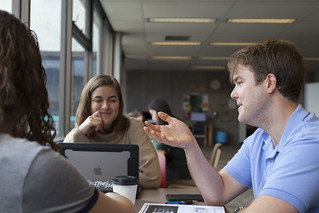Presenters: Megan Rolfs, @megrolfs
Josie Ahlquist, @josieahlquist
Elena Roth @elena_roth21
Megan Rolfs, Director of Marketing and Communications at Illinois State University Student Affairs Division, Josie Ahlquist, Higher Ed Digital Engagement & Leadership Consultant and Elena Roth, Marketing Graduate Assistant at Illinois State University, kicked off the session by asking attendees to share with their neighbor who has the most influence on their campus.
Some answers from the crowd:
-Student athletes
-Faculty-in-residence
-Presidents
-Everyone
Student influencers are called different things on each campus, including student leaders, a street team, brand ambassadors and more. Whatever they’re called, they serve the purpose to act as an authentic, relatable source to draw people in to whatever ask you’re trying to bring attention to.
Some of the deep-rooted goals of an influencer program include:
-Break through the noise of the Internet
-Be authentic to capture the community
-Be genuine
In Rolf’s new role, a formal student employee influencer position was created and the Student Influencer Program as it is today was born. The team of influencers is around six students at a time, with an additional creative team that creates the content, graphics and videos to manage the social media accounts.
The influencers are paid for around four hours per week, and have responsibilities such as sharing and retweeting content from the Student Affairs platforms, sharing the Division’s contests on social, comment/like a specific number of posts per week, enter a weekly report of influencer activity and attend monthly meetings and face-to-face outreach events monthly.
Rolfs says that it’s very important for everything to appear authentic. They do not tell them what content to engage with, encouraging them to engage with what they’re passionate about.
The #YourRedbirdLife Student Influencer program at Illinois State University has increased audiences by 113%, by students activating their personal networks. Engagement increases between 82-298% when influencers are active, as opposed to when they are not. Measuring success is important, and student feedback is a large part of this. They consistently check in with students one-on-one to make sure that they’re feeling good about the program, and that no one is feeling overtaxed.
The feedback that the team receives most is that they feel fulfilled contributing to the campus community, they feel that they are gaining practical experience and career preparation and a sense of belonging and identity development.
Finding influencers on your campus and creating a formal program may take a lot of trial and error, but when you find the right combination, it can be extremely beneficial to your university/division.
IMAGE:

